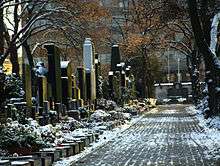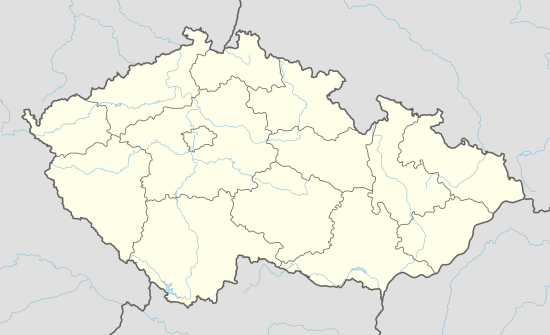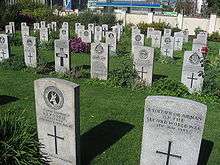Olšany Cemetery
 Olšany Cemetery in winter | |
 Olšany Cemetery | |
| Details | |
|---|---|
| Established | 1680 |
| Location | Prague |
| Country | Czech Republic |
| Coordinates | 50°04′50″N 14°28′14″E / 50.080556°N 14.470556°E |
| Type | Public |
| Style | art nouveau |
| Number of graves | 65,000 |
Olšany Cemeteries (Olšanské hřbitovy in Czech, Wolschan[1] in German) is the largest graveyard in Prague, Czech Republic, once having as many as two million burials. The graveyard is particularly noted for its many remarkable art nouveau monuments.[2]
History
The Olšany Cemeteries were created in 1680 to accommodate plague victims who died en masse in Prague and needed to be buried quickly. In 1787, when the plague again struck the city, Emperor Joseph II banned the burial of bodies within Prague city limits and Olšany Cemeteries were declared the central graveyard for hygiene purposes.[3]
The Olšany necropolis consists of twelve cemeteries, including, i.a., an Orthodox and a tiny Muslim section, the largest Jewish cemetery in the Czech Republic and military burial grounds. Among the thousands of military personnel buried at Olšany, there are Russian soldiers and officers from the Napoleonic Wars, members of the Czechoslovak Legion, Czechoslovak soldiers, officers and pilots who fought at the Eastern and Western Front and in North Africa during the Second World War as well as male and female members of the Soviet and Commonwealth (including British, Canadian, South African, Greek and Turkish Cypriot and Polish) armed forces who died for the freedom of Czechoslovakia in 1944-1945, including POWs. Based on a bilateral agreement, Czech authorities are responsible for the protection of Russian and Soviet military graves at the Czech territory (as the Russian Federation is responsible for protecting Czechoslovak war graves from both World Wars in Russia). The Commonwealth Prague War Cemetery, including 256 graves, was established under the terms of the 1949 War Graves Agreement between the UK and Czechoslovakia and is maintained by the Commonwealth War Graves Commission.
There are two ceremonial halls assigned to bid farewell to the deceased; the newer one is located in a building of the Prague's first crematorium. New to the scene is the "Olšany Cemeteries Learning Trail" which is so far mapping the history of three of the oldest sections, also sketching the life stories of some celebrities buried here. Prague's Olšany cemeteries excel in their picturesque style and tranquil nooks, surpassing even Malostranský cemetery and Slavín, being the biggest necropolis in the Czech Republic.[4]
Till this day there is evidence of 230,000 people buried, 65,000 grave sites, 200 chapel graves and six columbariums in Olšany Cemeteries.[5]
Part of the movie Bad Company was filmed in Olšany Cemeteries.
Famous burials


Many well-known people are buried at Olšany Cemeteries, including:
Writers, artists, and actors
- Karel Havlíček Borovský (1821–1856), writer
- Jaroslav Čermák (1831–1878), painter
- Viktor Dyk (1877–1931), writer and conservative politician
- Karel Jaromír Erben (1811–1870), writer
- Rudolf Hrušínský (1920–1994), actor
- Václav Kliment Klicpera (1792–1859), playwright
- Ján Kollár (1793–1852), Slovak Lutheran pastor, philologist and writer
- Josef Lada (1887–1957), artist and writer
- Viktor Oliva (1861–1928), artist
- Ossi Oswalda (1899-1948), German actress in silent film
- Jan Rejsa (1886-1971), artist, editor, and writer
- Pavel Jozef Šafárik (1795–1861), Slovak philologist and historian
- Antonín Slavíček (1870–1910), painter
- Ladislav Stroupežnický (1850–1892), playwright
- Jan Erazim Vocel (1803–1871), poet, archaeologist, historian and cultural revivalist
- Jiří Voskovec (1905–1981), actor and playwright
- Jan Werich (1905–1980), actor
Politicians
- Karel Kramář (1860–1937), politician and first Prime Minister of Czechoslovakia (November 1918 – July 1919) and his Russian wife Nadezhda (1862-1936) are buried in the crypt of the Dormition Church (Chrám Zesnutí přesvaté Bohorodice) in the Orthodox section of the cemetery
- Jan Syrový (1888–1970), general and Prime Minister of Czechoslovakia during the Munich Crisis (September–December 1938), as well as acting President following the resignation of Edvard Beneš
- Radola Gajda (1892–1948), military officer (and eventually general) with the Czechoslovak Legions in World War I and the Russian Civil War; later one of the founders of the fascist (yet anti-German) National Fascist Community and member of the Czechoslovakian Parliament
- Klement Gottwald (1896–1953), communist President of Czechoslovakia (1948–1953); his body was originally displayed in a mausoleum at the site of the Jan Žižka monument. In 1962 the body was cremated, the ashes returned to the Žižka Monument and placed in a sarcophagus. In 1990, Gottwald's ashes were moved to Olšany Cemetery, together with the ashes of about 20 other communist leaders which had also originally been placed in the Žižka Monument.[6]
Others
- Jan Palach (1948–1969), student who set himself on fire in Wenceslas Square (Prague) as a protest against the 1968 Warsaw Pact invasion of Czechoslovakia
- Pavel Roman (1943–1972), winner of four consecutive titles (1962, 1963, 1964, and 1965) in ice dancing at the World Figure Skating Championships with his sister Eva
References
- ↑ de:Olšany (Prag)
- ↑ Marie vitochova Jindrichkjer and Jiri Vsetecka, Prague and Art Nouveau, translation by Denis Rath and Mark Prescott, Prague: V Raji, 1995.
- ↑ "New Town and Suburbs (Nove Mesto) – Prague Attractions". PlanetWare. Retrieved 12 November 2012.
- ↑ "Beauty and Fame of Olšany Cemeteries (Portal of Prague)". Praha.eu. 8 December 2010. Retrieved 12 November 2012.
- ↑ "Beauty and Fame of Olšany Cemetery". Praha.com. Retrieved 12 November 2012.
- ↑ "Radio Prague: Exhibition at Vitkov Memorial highlights the Klement Gottwald personality cult". 8 March 2012. Retrieved 19 September 2012.
External links
| Wikimedia Commons has media related to Olšanské hřbitovy. |
- Cemetery details (in Czech)
- Olšany Cemetery (photo gallery)
- Transcripts of Headstones
- Photos of graves at Olšany , ,
- Photo gallery in 3-D